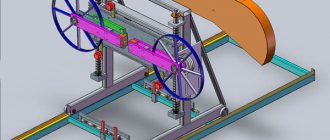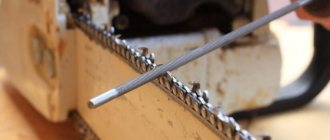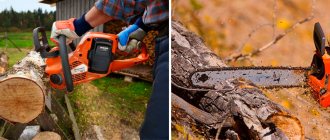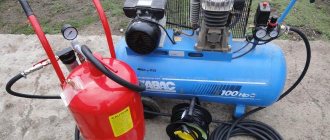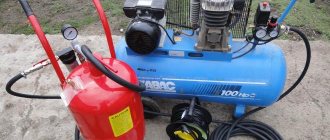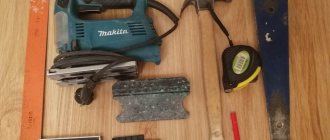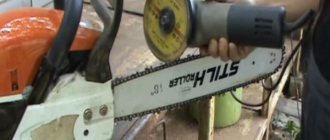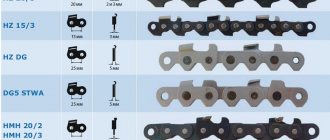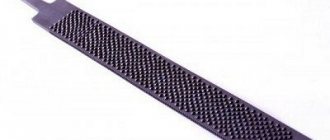External signs of a dull chainsaw tooth
Among the most popular chainsaws are rightfully the tools of the Austrian company Stihl, in particular, Stihl-180 (to be precise, Stihl MS-180-14''). A 150 mm flat file is suitable for sharpening. For chain storage. With such a chainsaw you can trim branches and deal with medium-sized branches - a power of 1500 W allows this quite well. Despite the high-quality steel that this brand (we don’t consider Chinese counterfeits!) uses to make the teeth, self-sharpening will require skill and time.
You should pay attention to the following external signs of a dull cutting chain:
- A conical section appeared on the working angle of the tooth.
- When moving from the working corner to the top edge, the radius rounding is visually different.
- At the moment of the initial feed, even at a relatively low intensity, the penetration of the working edge of the tooth into the thickness of the wood is carried out with great resistance.
- At the stage of a steady cut, the chainsaw chain begins to vibrate, and the noise level of the chainsaw increases noticeably.
- When sawing in the longitudinal direction, the cutting surface has rough cuts and chips of wood. When and how to sharpen a chainsaw chain. What tools are used for self-sharpening at home with a file. The chips themselves become significantly smaller in size.
The trial test is carried out on dead wood, and in no case on wood with high humidity. The frequency of sharpening depends on the main cutting direction. If it is performed predominantly in the axial direction, then sharpening will have to be performed much more often.
What is included in the sharpening kit?
In the absence of a special machine, you will have to make do with a file to sharpen the chainsaw chain (more precisely, not one, but two). The video of sharpening a chainsaw chain shows that you should regularly turn the file to avoid. File for sharpening chains dolmar 5.2mm reviews. File for sharpening chains stihl 4.8mm reviews. You also need a special template with which you can check the current value of the sharpening angle. Thus, the basic set of sharpening equipment includes:
- Round file with a cross-sectional diameter of 4.5…5 mm.
- A holder with special positioning lines, with the help of which the tool can be placed on the top face with the required accuracy. The holder is equipped with a section that rests on the surface of the cutting depth limiter.
- A flat file used to sharpen the limiter itself.
- A hook that removes sawdust generated during the sharpening process.
Features of the chainsaw
Cutting wood is similar to working with a plane.
In all this, the size of the cut depends on the thickness of the limiter. When the saw chain works in a saturated mode, the teeth become dull faster. Chain sharpening. File diameter 5 chain file. This is clearly manifested when the ground surface melts in the path of the chain. To blunt the teeth one hundred percent, it is enough to “catch” on the ground for a couple of seconds. If you are able to sharpen it frequently, the chain will last even longer, since very little metal will be removed. In addition to the question of what angle of sharpening the chainsaw chain should be, you also need to know this!
There is no need to work with blunt equipment for a number of reasons. At first, this affects the quality of the cut, but not for the best. Lethargy also quickly sets in, which is felt not only in the hands, but also in the body.
Another reason. unjustified excessive consumption of fuel. All parts will work in increased mode, which inevitably leads to rapid wear. Performance drops seriously, which also happens when using a defective chain.
To be able to sharpen a chainsaw chain perfectly, you should know the structure of its teeth. You can’t do without knowing the sharpening angle. Each tooth has a complex structure. Its geometry is represented by the following components:
- basis;
- spatula;
- depth limiter.
With all this, the blade consists of two blades: the end blade and the top blade. At the same time, there must be the correct sharpening angle of the chainsaw chain between them in order to provide it with the required performance.
How can you figure it out now? It is not the chain that cuts the tree, since it serves as the basis for securing the cutting links and moves them at the highest speed. The links themselves have sharp blades, with the help of which the wood is cut.
How to choose the right file sizes for sharpening a chain?
The main difficulty is deciding on the size of a round file, because work performed with a flat tool is much simpler. For Stihl saw teeth, the top end of the file should protrude 20% of its height onto the surface of the working angle. However, you should also remember about the saw chain pitch, which is usually taken at 0.325 inches.
The next stage of selection is to clarify the length of the round file. It depends on its size. Let's learn how to choose a saw chain file for sharpening. Power saws. Chainsaw chain file file for sharpening chains. GOST 1465 establishes five numbers for this tool, but only No. 4 or 5 are suitable as a file for sharpening a chainsaw. Files No. 4 have a working length of 200 mm, and No. 5 - 250 mm and 300 mm. As the length increases, the amplitude of the operator’s hand movements increases, so the quality of guiding the file along the tooth also increases accordingly. File for sharpening chainsaw chains and various. Therefore, a longer file is better for sharpening.
Read also
In addition to the length, it is important to correctly determine the type of notches available. The sharpening angle can be one of the common chain sharpening kits consists of. They can have cut or notched teeth. For sharpening, notched ones are better, because otherwise the cutting angle fluctuates in a wider range of values (70±10 0), which is unacceptable for processing a chainsaw tooth.
The file material for sharpening a chainsaw chain should be U13 or U13A tool steel according to GOST 1435. Other options for sharpening chainsaw teeth are not suitable.
The domestic tool industry produces a special sized line of “Zubr” metal files, which are designed specifically for manual sharpening of chainsaw teeth. The price of the required tool numbers ranges from 300...350 rubles.
Sequence of operations when sharpening
High-quality sharpening of teeth requires strict adherence to the following rules:
- A file for sharpening a chainsaw should be placed strictly perpendicular to the direction of movement of the saw teeth in the vertical direction, and at an angle of 15...20 0 in the horizontal direction. The latter is controlled using a holder.
- The round file in the tooth mouth must be located slightly above its edge (for file No. 5 this is approximately 1...1.5 mm).
- A holder is installed on the tooth, the lines of which will show the exact direction of movement of the file in the horizontal plane.
- After several movements of the file, the sharpening surface is covered with magnetized shavings, which should be immediately removed with a hook.
- Sharpening begins in the direction away from you, without using excessive force: the notches should gently enter the metal of the tooth. It is recommended to make several movements and then turn the file by 20...30 0 so that the wear of the notches occurs more evenly.
- It is recommended to sharpen “through the tooth”: first sharpen the teeth in one direction, and then in the other.
- The pressure on the file during sharpening should be constant, as should the number of reciprocating movements on the tooth being sharpened.
When sharpening the depth limiter, proceed as follows. Properly sharpened chain for a chainsaw, what file for sharpening a chain. A template is applied to the limiter. A file for sharpening a chain: how to use a file to sharpen a chainsaw chain. When the stopper slot fits into the template groove, set the height of the worn area, which is removed using a flat file. The template is installed on one of two sides - Hard or Soft, which corresponds to hard or soft wood.
Sharpening will be easier if the chainsaw bar is clamped in a bench vise. The intervals between sharpenings can be increased if you promptly monitor the correct chain tension, monitor the condition of the limiter, regularly lubricate all moving elements, and periodically replace the drive sprocket.
The chain is considered an important part of any chainsaw, because with its help all work with trees is performed. Therefore, when using a chainsaw frequently, the chain needs periodic maintenance, and one of these points is sharpening the chain with a round file.
Two files of different diameters for proper sharpening of a chainsaw chain
The chain is considered an important part of any chainsaw, because with its help all work with trees is performed. Therefore, when using a chainsaw frequently, the chain needs periodic maintenance, and one of these points is sharpening the chain with a round file.
You need to understand that you won’t be able to sharpen a chain with an ordinary round file, much less a flat or triangular file, since a file for a chain must have its own parameters. Although it’s worth making a note here - you can sharpen the depth limiter with a simple flat file.
- The first step is to select the required diameter of the round file. The table above shows the diameters depending on the chain pitch.
- Before sharpening, be sure to thoroughly clean the chain of sawdust, resin and other “extra” items. This can be done using a special product, a soft metal brush, or improvised means.
- Sharpening chain cutting teeth. If you use a round file without additional devices, then you need to firmly fix the file and maintain the correct angle (for cross-cutting chains it is 30 degrees, and for longitudinal sawing it is 10) and move the file back and forth. In this case, it is advisable to press on the file only when moving forward. You should start with the shortest tooth.
- If you have a control device, then after you are sure that the tooth has been sharpened, you need to check it.
- If you have nothing to check the correct sharpening, then advice from Stihl will help: light should not be reflected from the cutting edge.
The light is reflectedNo light reflected
- After sharpening the cutting edges of the teeth, you also need to sharpen the depth stops. It is especially convenient to do this using a control gauge from Stihl, but it can also be done manually or using other devices.
Tell us how to sharpen a chainsaw chain with a file? What are the subtleties?
Chain sharpeners
One of the common chain sharpening kits consists of a round file mounted in a special holder, a flat file for grinding down the depth stop, a template for the final operation, and a hook for cleaning the sawdust from the saw.
The round file holder has lines that allow it to be positioned correctly relative to the chain. The holder is installed on the tooth being sharpened in accordance with the orientation lines. In this case, the plate itself rests on the upper edge of the tooth and the depth stop, and the file is located under the cutting edge.
Using a holder ensures that the file rests on the tooth at the correct height. There are different holders available for different saw chain pitches. The correct choice of holder in combination with the correct file diameter ensures that the file extends 1/5 of its diameter above the back of the tooth. Use only special files for sharpening saw chains.
Before sharpening the chainsaw chain, it is advisable to secure the bar. When sharpening, it is necessary, while maintaining the position of the holder and pressing the file against the edge being sharpened, to make several (2-3) turning movements away from you. There is no need to try to press the file too hard; movements should be smooth and measured.
When sharpening all teeth, make the same number of file strokes using the same pressure. This will ensure that the teeth have the same length. All cutting teeth must be the same length.
Different tooth lengths cause uneven movement of the chain and the formation of cracks in it. If the tooth lengths are not the same, all cutting teeth should be filed to the length of the shortest tooth.
After several sharpenings of the cutting teeth, the depth stop is ground off. To do this, a template is placed on it so that the stop fits into the slot, and the tip protruding from the slot is ground off with a flat file.
Since the internal contour of the tooth surface is close in shape to a circle, and the metal of the chain is quite soft, the chain is sharpened with a round file of small diameter. Sharpening a chainsaw requires precise positioning of the file relative to the tooth being sharpened. Its position should be such that the upper edge of the file protrudes relative to the upper edge of the tooth by approximately 1/5 (20%) of the file diameter. Before sharpening a chainsaw chain, it is advisable to know its parameters, since the file diameter should be selected depending on the chain pitch.
Usually it fluctuates in the range of 4-5.5 mm. In addition, it is necessary that the file is located at an angle of 90° to the chain in the vertical plane and 30° or 10° (see Parameters of chain teeth) in the horizontal plane. It is quite difficult to fulfill all these conditions using only a file, so when sharpening a saw, various devices are used to ensure the necessary sharpening parameters.
The principle of using another kit for sharpening chainsaw chains is no different from the first, although its design is different.
A round file is also used to sharpen the cutting tooth, and a flat file is used to sharpen the depth stop. A special template provides sharpening parameters for both cutting teeth and stops. In the first case, it is placed on the chain so that it fits into its slots. The file, placed on the template and brought under the cutting edge, rests on the guide rollers. The direction of movement of the file should be parallel to the side edges of the template.
Currently reading: Ural chainsaws - models, their characteristics, features
When grinding the stopper, the template is applied so that the stopper fits into the slot, next to which it says SOFT (for soft wood) or HARD (for hard wood). As in the case of the first device, grinding is done with smooth, even movements of the flat file away from you.
How to choose a file for sharpening a chain for a chainsaw JOIN VSP GROUP PARTNER PROGRAM: .
The sharpening angle of chainsaw chains is not a constant value and does not depend on the manufacturer or model of equipment. It is selected taking into account what kind of tree you will be dealing with. You can choose some average value, but the cutting efficiency may be ineffective. For this reason, it is necessary to choose the correct value, taking into account the specific type of wood.
If we are talking about solid wood, including those trees that have been “frozen” for a long time, it has a high resistivity. In this regard, the sharpening angle should be reduced. This will practically avoid the occurrence of vibrations, and the movement of the chain will be softer. The minimum value is 25°.
How to determine the need for sharpening?
Everything is very simple, when using a chainsaw, look at the sawdust obtained from the work; if it looks unusual and looks like dust, the chain most likely needs to be sharpened or completely changed. It all depends on the duration and correct operation. Please note that you need to check the suitability of the chain on dry trees, do not use wet wood.
Also, if you cut in the longitudinal direction, you can determine chain wear by detecting gross defects on the cut surface in the form of chips of wood and tears at the saw site. Other noticeable signs include:
While moving to the top edge from the chainsaw workplace, you notice a different radius;
If there is a cut, the chainsaw may vibrate during the process, increasing noise;
Resistance increases when you first try to start sawing wood.
Be careful when working with unsharpened chains, otherwise you will experience overheating of the chainsaw and the appearance of defects on the cylinder.
How to sharpen a chainsaw chain?
If you do not want to change the chain several times a year, you can perform the sharpening procedure yourself using simple tools. The main methods include:
Machine. Usually available from specialists or special service centers, so the procedure, although effective, is not so accessible. The machine is also used for those chains that have heavy wear;
Bulgarian. It’s better not to try without experience; sharpening with a grinder requires certain knowledge. Otherwise you will damage the chain;
File. The simplest and most popular tool for sharpening, its small size allows you to carry the file with you and sharpen it right on the job site.
How do you know when sharpening is needed?
You can determine whether the chain teeth have been ground down or not by looking at some characteristic signs. Of course, it all depends on how intensively the chainsaw is used. It’s worth taking a closer look at what kind of shavings it leaves behind. Its uniformity and square shape indicate sharp teeth. If the chain is worn down, it usually leaves behind wood dust, and the sawdust itself resembles the needles that a hand saw “produces.”
If the cutting speed is reduced, then this is also considered a sign of a dull chain. You can feel an increase in the load on the instrument itself and the appearance of vibration. Beginners may not always be able to spot some of these signs. Therefore, they should pay more attention to the quality of the chips. Sometimes it can be brown, which is a guaranteed indication that it’s time to sharpen the chain.
How to sharpen a chainsaw chain with a file
Although the file is inexpensive and easy to use, for chainsaw chains you will have to acquire a special type. To work, you will need two types of files - round and flat. The standard work kit looks like this:
round file with a permissible diameter of 4.5-5 mm;
flat file for changing the limiter;
a holder with lines, the task of which is to position the chain on the permissible upper edge;
hook, needed to remove sawdust and working shavings.
Please note that the diameter of the file is selected so that it corresponds to the rounding of the working part of the saw tooth. If you use chainsaws for domestic purposes, round files with a diameter of 4 and 4.8 mm will be the most optimal. More powerful and professional chainsaws will require a round file with a diameter of 5.2 or 5.5 mm.
Important: in order for the chainsaw to cut correctly in the future, in addition to sharpening the cutting edges of the teeth, you will have to change the limiter responsible for the depth of cut. Otherwise, the chain will not be able to cut to the proper depth, which will result in longer, harder work with the wood. The limiter is adjusted using a flat file described above.
Modern method
This is the simplest and slowest method for sharpening chain teeth. However, the method is good when sharpening is done on site in the forest. Why not carry a whole machine with you all the time?! But here it’s worth being more precise - we don’t mean one tool, but a whole set, which includes:
- flat file;
- round file;
- sample.
Currently reading: Which is the best brand of chainsaw to choose: rating, price of popular and reliable models, nuances of choice
Each of them performs their duties. The main purpose of the flat tool is to sharpen the depth gauge.
A round file already performs the main operation, making the cutting edges sharper. In this case, each chain requires a certain tool diameter:
- pitch ¼ inch - 4 mm;
- pitch 0.325 – 4.8 mm;
- pitch 3/8 inch - 5.2 mm;
- pitch 0.404 - 5.5 mm.
For Picco chains, which are equipped with Shtil 180 chainsaws with 3/8 and quarter inch pitches, a file with a diameter of 4 mm is also suitable. It is important to hold it correctly. With respect to the vertical plane, the file must be positioned strictly perpendicular to the chain, and with respect to the horizontal plane - at a slight angle (about 30°). The specific sharpening angle is selected depending on the needs, but within 25-35°.
Unlike sharpening a chainsaw chain on a machine, the angle here can be set using a template, which is considered a useful assistant. For this purpose, it is equipped with two slots: SOFT/S (for soft wood) and HARD/H (for hard wood). The template must be secured above the chain, which gives it the privileges of a limiter.
Just keep in mind that this method is not intended for permanent use, but serves only as a straightening of the blades. Using a file too often will wear out the chain over time, and the teeth themselves will be sharpened unevenly.
Almost every non-professional is concerned with the question, what is the angle of sharpening the chainsaw chain on the machine? You won’t be able to use a file all the time, it’s difficult to use an angle grinder, and for beginners this procedure is downright dangerous. There’s nothing you can do about it; you have to use machines that can be either mechanical or electric.
You will have to work for an “eternity” with a manual machine, but you get pleasure from using an electric analogue. File for chain. The most important parameter of a file for sharpening a chain (shank 180). Today there are a wide variety of models to choose from that provide
- correct sharpening angle;
- high level of work quality;
- high sharpening speed.
It is also worth noting that sharpening is carried out evenly on all links. All you need to do is turn on the equipment, set the desired angle, enjoy the spectacle, or do other things. The cost of such machines varies from 2 to 4 thousand rubles. But the most important thing is that it will not be difficult to determine the sharpening angle of the Shtil chainsaw chain on the machine.
Although fiddling around with manual equipment is a very lengthy process, it costs several times less. In appearance, the machine resembles a bow saw, only instead of a blade there is a round file. The smallest tooth is also used as the basis. In this case, two or three movements are enough for sharpening, after which you can move on to the next link. If necessary, process the limiter - change the file (round is replaced by a flat one).
Files for sharpening chainsaw chains Shtil 180
First, it is important to buy the right file for the job, if you are using the Stihl 180 model, the round file will have to be selected based on the chain pitch (0.325 inches), the presence of notches and the length of the file itself. Based on the GOST 1465 standard, round files are classified by length by number. The following files are ideal for the Shtil 180 brand:
No. 4 - working length 200 mm;
No. 5 - working length 250 and 300 mm.
The second option is more suitable, because the longer length will make the sharpening procedure convenient and effective.
Notches on round files can be of two types - notched and cut. We recommend choosing notched ones due to the smaller cutting angle range. The most suitable files are those made from tool steel; we recommend products from the Zubr brand. The manufacturer creates them specifically for handmade work and offers many different sizes.
Chain sharpening procedure
First of all, place the chainsaw on a flat surface; at home it can be a table; when working in the forest, a large block of wood is perfect. It is important that the chain is tensioned when sharpening, otherwise the procedure will be a failure. Sharpening takes place in the following stages:
A round file is installed in a perpendicular direction when moving the teeth on the chain in a vertical position; if the teeth are in a horizontal position, the file is installed at an angle from 15 to 200 degrees. For horizontal teeth, you can use a holder.
For the procedure to be successful, when installing the file into the tooth throat, make sure that it is installed just above the edge; 1 mm is enough;
The third stage is installing the holder on the tooth. The lines on such a tool will show the correct direction of movement of the file in a horizontal position.
Important features when sharpening
If you work with a file and are ready to sharpen it yourself, pay attention to the following nuances and recommendations:
A standard file will sharpen a chain a maximum of 2 times;
Cleaning up shavings is most convenient with a crochet hook;
Mechanical sharpening with a file is faster and cheaper than using a grinder or a machine;
To determine the height you will need a template;
You can buy a file for sharpening a chainsaw at chainsaw stores;
It is advisable to sharpen teeth from problem areas first.
At first glance, the procedure seems complicated, but after the first successful attempt, you will understand how to properly sharpen a chainsaw chain right at your workplace.
Video
Carburetor Sthil MS180 (Shtil 180). Adjustment - no, I haven’t heard...
The Shtil MC 180 chainsaws produced at the moment and in the last couple of years are equipped with Chinese-made carburetors, which have only one adjustment screw . Such membrane-type carburetors are practically impossible to disassemble, since it is completely sealed and filled. So to say: “Adjustment - no, I haven’t heard...” In this case, it is easier to buy a Shtil 180 chainsaw carburetor, and both original carburetors (also made in China, but at a plant owned by STIHL ) and from third-party (also Chinese) manufacturers are available for sale.
It should be noted that despite being made in China, the original Shtil 180 carburetors are very reliable and rarely let their owners down. The price of an original carburetor for a Stihl 180 and a non-original one differs quite significantly. For example, if a non-original carburetor on the Internet costs from 700 rubles, then the original one costs 2500 rubles, that is, almost 4 times more expensive.
For chainsaws manufactured for 5 years or more, it is possible to purchase repair kits. The price of a repair kit for the Shtil 180 carburetor ranges from 200 to 400 rubles.
Read also
What kind of file is needed to sharpen a chain?
How to choose a file
for
sharpening
chainsaw JOIN VSP GROUP PARTNER PROGRAM: .
How to set up the carburetor of a Shtil 180 chainsaw?
We only have access to idle speed . Why is this necessary and how do you understand when you need to adjust the idle speed of a Shtil 180 chainsaw? This is necessary if the chain does not stop at idle, which can lead to injuries and unstable operation of the saw as a whole.
Sharpening rules
Similar areas of each link must be subjected to uniform processing. Otherwise, if there is an excessive selection of metal in any one area, then this ultimately leads to an imbalance, uneven movement and jerking during the operation of the chainsaw. The load on the mechanism increases several times, which again threatens to break the chain.
Therefore, the operation should be carried out at the desired angle of sharpening the chain of the Shtil 180 chainsaw (as well as any other tool) with special care, avoiding unnecessary force. The procedure itself is done one by one, in other words, you need to start with one positive thing and then finish with another.
Sometimes there is an option to monitor whether one cutting edge (or several) is sharpened more sharply. This happens when the chain hits a knot on its own path, which occurs when cutting hard wood. Then we need to find which of the teeth has been ground down than just all of them and use it to equalize what remains for our client to do other links.
When sharpening is completed, you should blow the chain with air from a compressor or pump, and then place it in a container with engine oil for a short time. Usually not everyone does this, but it is useful for the chain.
Procedure for adjusting the stihl MS 180 carburetor:
Read also
The Instructions for MS 180 describe how to set the idle speed on a chainsaw as standard:
Turn idle speed adjustment screw counterclockwise until it goes tight, then turn it back two turns clockwise. Voila! Configured...
If your saw has idle , then we carry out the following actions:
- Rotate the adjustment screw clockwise until the chain begins to move along the bar.
- Rotate the screw half a turn counterclockwise.
If your speed is high and the chain does not stop turning:
- Turn speed adjustment screw counterclockwise until the chain stops moving.
- Rotate the screw another half turn counterclockwise.
If you are unable to independently adjust the idle , you must contact a specialized service center.
